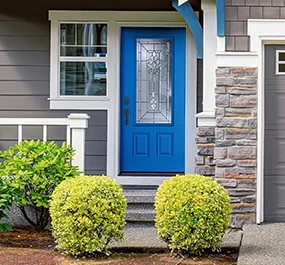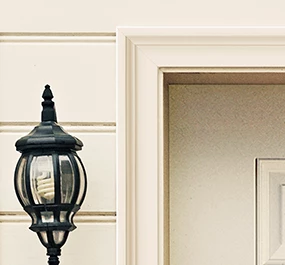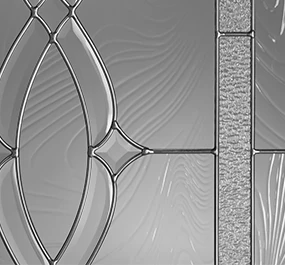When it comes to home security, a reliable lock may be the single most important thing on your home’s list of protections and deterrents. A lock that performs well will prevent easy access to your home, causing any would-be intruders to consider routes that make noise or bring attention to their activities—this can be enough to completely discourage a burglary altogether. On the less harrowing side of things, a good lock will provide a sense of security for you and your family, helping you rest easy knowing your home and everything important inside is safe and secure.
You may also want to change the lock on an exterior door for a reason that doesn’t have to do with security. Maybe you prefer the use or look of one lock type over another. Maybe you’d like to enhance the curb appeal of your door by swapping locks and adding an ornate aesthetic to your home’s protection.
Whatever the motivation for your lock replacement, questions arise once you finally decide—or are forced to—begin the process. How much will this project cost? Can you change a door lock without professional help? If you can, is it too hard for the average homeowner to accomplish? Luckily, the answers to most of your questions will be favorable to the average homeowner.
Can You Change Your Front Door Lock Yourself?
Depending on your experience and skill level, you can complete a wide array of tasks around your home without the need to enlist help from someone who completes repairs and installations on a professional basis. When it comes to at-home DIY projects, though, most homeowners should be able to choose, purchase and install lock-on-door protection for the main exterior entrance of their home without the whole process becoming headache inducing.
Today, most locks will come with a set of instructions that allow you to complete the job in 1-to-2 hours, and most lock replacements can be completed with tools and materials homeowners are likely to already have around their home. For those locks that come lacking instructions, the advent of widespread internet access has made an ever-growing collection of resources available to any homeowner who wants to know how to change a door lock. In the case of a lock installation, the cost of professional help can be double the price of a lock—that means it could triple the price tag of the project itself.
Types of Door Locks
When you’re choosing the kind of lock that’ll protect your home, it’s best to weigh each available option before making a final decision. There’s a large selection of locks that act as affordable choices that’ll usually equip your front door with industry standard protection. There are other options that are more complicated and more expensive, but those are usually used to secure assets found on commercial properties. For the purposes of most people’s homes, one of the below locks is a perfect fit.
Deadbolt Locks
Considered a high security option for your home, deadbolts are rated on a system that shows the level of force each can withstand. This lock option doesn’t include springs as part of its construction, making it a simple lock that can be operated from the interior with a turning button or from the exterior with a key.
Cylinder Locks
This is one of the most common types of locks used to secure the exterior door of a structure. It can be operated with either a level or a knob. It locks from the inside with a push button and secures or opens from the outside with a key. However, despite its popularity—or maybe because of it—intruders have developed a few methods for disarming the cylinder lock. Because of this, a deadbolt lock is often used in tandem with cylinder locks to secure a building.
Multipoint Locks
Have you ever been to a bank that had its large vault door open? Did you notice how the door has multiple metal rods sticking out of each side? A multipoint lock secures your exterior door in a similar way, with locking points usually located at the bottom, middle or top of a door. This differs from the usual door lock, which secures from the middle of a door.
Those extra locking points make it harder for a door to be opened by force. This is particularly useful if a door is large, as the further a door gets away from its lock, the weaker its resistance to forceful entry. As an added bonus, those extra locking points add stabilization and help prevent warping at the further ends of a door.
Smart Locks
This choice is less mechanical than technological, but it can simplify home entry while allowing for a door’s locking mechanism to be better protected from tampering.
Smart locks open with a code that’s only available to those you share it with and most can be controlled with a smartphone app that allows you to lock it, change the code or more from anywhere in the world.
Installing or Changing an Exterior Door Lock
Once you’ve decided to replace your front door’s lock and you’ve picked a brand or type of lock, it’s time to visit a store or order the lock online. You’ll find that a lot of locks tout security ratings and other tangible or intangible features in their product descriptions, but you’ll also find that prices tend to remain similar despite these advertised features. The most important thing is to choose a lock that you’re happy with—and that falls within your predetermined budget.
Door Prep
Open the door to a comfortable position and tape two pieces of wood—usually referred to as shims when used in this manner—between the floor and the bottom of the door. This will help it stay steady despite being swung open.
Next, mark the spot where you want your new knob to be placed on the edge of the door. Use a square to extend this mark across the front of a door. Usually, about 3 inches of extension will do the trick.
Drill a Face Bore and Edge Bore
Hopefully, your lock came with a template that’ll allow you to center your mark in a circle. This circle is the face bore that’ll be drilled into the door. Use the guide to create and drill your face bore using a hole saw’s pilot bit. Next, use a 7/8 spade bit at medium speed to create an edge bore.
Installing a Latch and Knob
Place the latch assembly through your newly cut edge and outland the plate’s rectangular shape onto the door. Remove the assembly and chisel a space in the door for the plate. Be sure to only chisel as deep as the plate’s thickness. Insert the assembly again, mark the location of its screws, take it back out and drill pilot holes. Reinsert the place and affix it.
Take the outside knob through the face bore and latch, then fit the inside knob over the outside knob’s spindle. Thread screws by hand, then tighten with a screwdriver.
Installing the Strike Plate
Close the door and mark at the latch’s midpoint. Use a square to extend this mark across to the frame. Open the door and extend it into the inside of the frame. Use the same chisel technique above to create a space for the door to lock and install the strike plate over that space. The strike plate should be large enough to accommodate the lock it came with.
Improving Your Home Security
Door locks are a great way to help keep your home secure, but they’re one of many different options that’ll help improve your front door’s overall level of protection.
A door that swings out rather than in will be more difficult for people on the outside of a home to open using force. To benefit from this door configuration, make sure you use non-removable pins on your hinges since they’ll be accessible from the outside of your home. Speaking of door hardware, using longer hinge screws will provide your door with more support. Go with screws that are at least 2.5 inches long.
If your door has glass features, they can be much easier to damage, allowing for access to your home. Impact glass is expensive, but security film is another option that effectively turns your existing glass into impact glass. If stronger glass doesn’t frustrate an intruder into abandoning a crime in progress, it’ll still provide more precious time for responders to arrive at the scene.
When it comes to technology, smart home products can help instantaneously identify the presence of possible intruders and alert you or the authorities of the incident. These products can also take a recording of the moments in question, which helps explain what’s going on around your front door.
Lastly, pay attention to a door’s impact ratings, as these will help you select doors that can withstand attempts at forceful entry. Wind Borne Debris (WBD) Resistant rated doors can hold up to encounters with objects sent flying because of high winds. Fiberglass doors are a great option for impact resistance, as they’re multi-layer products that won’t rust or dent like metal and feature more layered protection than most wooden doors.
Protect Your Home with Plastpro
Most of Plastpro’s fiberglass doors are rated WBD Windload Resistant—some are even rated to withstand debris sent flying by hurricane winds. This, coupled with the aforementioned impact resistance, multi-layer construction and resistance to cracking make fiberglass an amazing option for home protection. Additionally, fiberglass doors are more energy efficient than their wood or metal counterparts, helping you save on energy bills!
Find a Plastpro dealer to learn more about the security benefits of fiberglass doors, as well as the large selection of customization options available.



